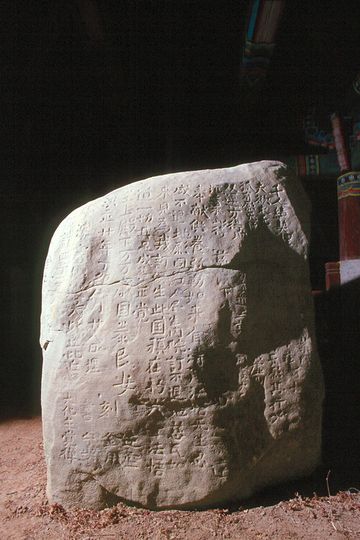사천 흥사리 매향비
| 사천 흥사리 매향비 Monument for the Incense Burial Ceremony in Heungsa-ri, Sacheon |
|
 사천 흥사리 매향비, 국가문화유산포털, 문화재청. |
|
| 대표명칭 | 사천 흥사리 매향비 |
|---|---|
| 영문명칭 | Monument for the Incense Burial Ceremony in Heungsa-ri, Sacheon |
| 한자 | 泗川 興士里 埋香碑 |
| 주소 | 경상남도 사천시 곤양면 흥사리 산48-2번지 |
| 지정번호 | 보물 제614호 |
| 지정일 | 1978년 3월 8일 |
| 분류 | 기록유산/서각류/금석각류/비 |
| 시대 | 고려시대 |
| 수량/면적 | 1기 |
| 웹사이트 | 사천 흥사리 매향비, 국가문화유산포털, 문화재청. |
|
|
|
해설문
국문
매향이란 내세*의 복을 빌고자 향(香)을 강이나 바다에 묻는 일을 말하며, 이런 의식을 치르는 과정과 시기, 관련 집단 등을 기록한 비석을 매향비라고 한다.
이 비석은 고려 우왕 13년(1387)에 세워진 것으로 자연석 위에 17행 204자를 새겼다. 오랜 시간 비바람에 닳아서 없어진 부분이 많은데, 다행히도 판독되지 않은 글자는 하나밖에 없다. 정치가 혼란하던 고려 시대 말에 승려를 중심으로 4,100명이 계(契)를 조직하여 나라의 평안함과 백성의 안녕을 빌고자 매향 의식을 치렀다는 내용이 적혀 있다. 승려 달공이 문장을 짓고 수안이 글씨를 썼으며 김용이 새겼다.
현재 국내에서 발견된 매향비 중 매향 의식과 관련된 비석은 세 곳뿐이며, 이 비석은 매향비를 세운 목적과 연대가 확실하게 밝혀져 있어서 가치가 매우 높다.
*내세(來世): 죽은 뒤에 다시 태어나 산다는 미래의 세상
영문
Monument for the Incense Burial Ceremony in Heungsa-ri, Sacheon
An incense burial ceremony is a ritual wishing good fortune for the afterlife. When the ceremony was completed, a monument was erected with an inscription including the date, process, people involved, and the purpose of the ceremony.
This monument records an incense burial ceremony held in 1387. There are 204 Chinese characters inscribed on the surface. Because the stele remains in good condition despite its old age, all but one character are legible.
The record explains that 4,100 people, including monks, gathered and performed the ceremony praying to Maitreya (the Buddha of the Future) for peace of the country and the well-being of the people. The purpose of this ceremony seems to have been to comfort the people of the coastal areas, who were distraught due to frequent invasions by Japanese pirates and social disorder.
영문 해설 내용
매향이란 내세의 복을 염원하면서 향(香)을 묻는 의식을 말한다. 매향 의식을 치르고 나면 의식의 과정, 시기, 관련집단, 발원의 내용 등을 기록한 비석을 세웠다.
이 비석은 1387년에 치러진 매향 의식을 기록한 것이다. 자연석 표면에 204자를 새겼는데, 오랜 세월에도 불구하고 보존 상태가 좋아 한 글자를 제외한 모든 글자가 판독되었다.
비문에는 승려를 중심으로 4,100명이 모여, 나라의 평안함과 백성의 안녕을 미륵불에게 빌고자 매향 의식을 치렀다는 내용이 적혀 있다. 이 시기는 왜구의 횡포가 극심하고, 사회가 혼란하던 때였다. 이에 해안지역민의 불안한 민심을 매향을 통해 위로하려 한 것으로 보인다.
참고
- "사천매향비", 한국금석문종합영상정보시스템, 국립문화재연구소.